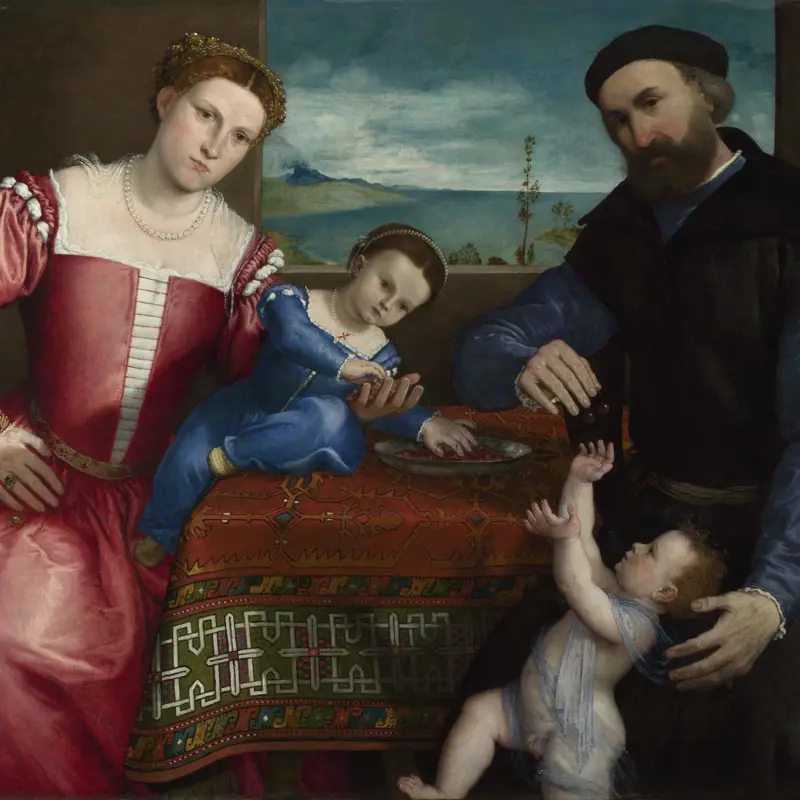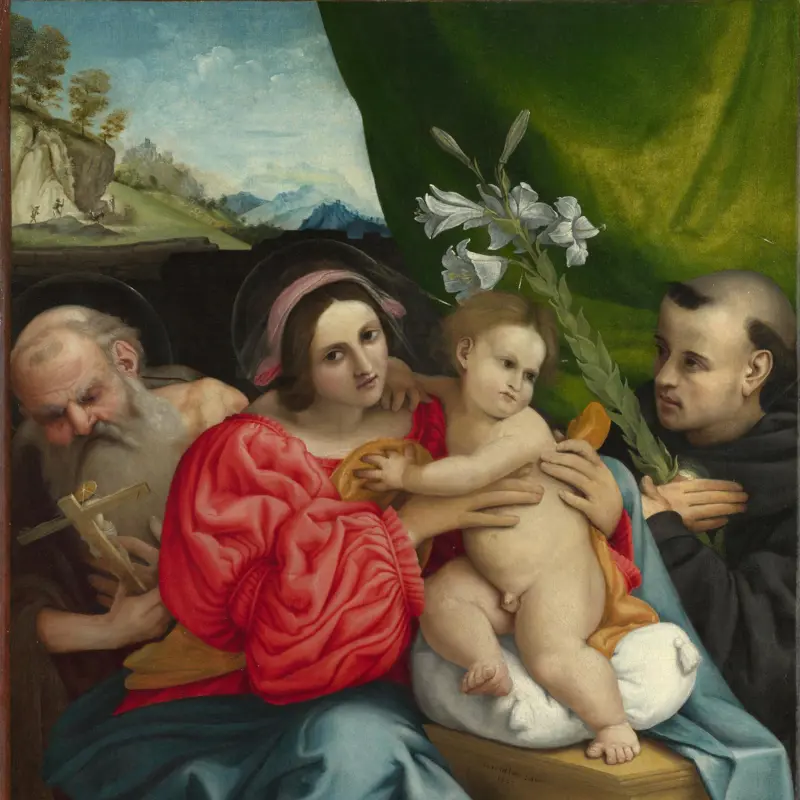Lorenzo Lotto, 'Portrait of a Woman inspired by Lucretia', about 1530-3
About the work
Overview
A sumptuously dressed young woman holds a drawing of the Roman heroine Lucretia. The story of Lucretia, who lived in the early sixth century BC, is told in Livy’s History of Rome. Prince Sextus Tarquinius crept to Lucretia’s room at night and raped her. She told her father and husband, who were unable to dissuade her from killing herself.
Lucretia’s last words are written on a paper on the table in this portrait. The Latin phrase is difficult to translate but roughly means that by killing herself Lucretia will deprive unchaste women of a possible excuse for living. Also on the table is a yellow wallflower, sometimes a lover’s gift. The woman wears a gold wedding ring and a type of jewelled gold pendant associated with weddings. The empty chair may suggest her absent husband.
The sitter in Lotto’s portrait, who was very likely called Lucretia, seems to be saying that she would follow her heroine’s example.
Key facts
Details
- Full title
- Portrait of a Woman inspired by Lucretia
- Artist
- Lorenzo Lotto
- Artist dates
- about 1480 - 1556/7
- Date made
- about 1530-3
- Medium and support
- oil on canvas
- Dimensions
- 96.5 × 110.6 cm
- Acquisition credit
- Bought with contributions from the Benson family and the Art Fund, 1927.
- Inventory number
- NG4256
- Location
- Room 4
- Collection
- Main Collection
- Frame
- 16th-century Italian Frame
Provenance
Additional information
Text extracted from the ‘Provenance’ section of the catalogue entry in Nicholas Penny, ‘National Gallery Catalogues: The Sixteenth Century Italian Paintings’, vol. 1, ‘Paintings from Bergamo, Brescia and Cremona’, London 2004; for further information, see the full catalogue entry.
Exhibition history
-
2008Renaissance Faces: Van Eyck to TitianThe National Gallery (London)15 October 2008 - 18 January 2009
-
2018Lorenzo Lotto PortraitsMuseo Nacional del Prado19 June 2018 - 30 September 2018The National Gallery (London)5 November 2018 - 10 February 2019
-
2019Pietro Aretino and the Art of the RenaissanceGallerie degli Uffizi27 November 2019 - 1 March 2020
-
2021Titian’s Vision of WomenKunsthistorisches Museum Wien5 October 2021 - 30 January 2022
Bibliography
-
1871J.A. Crowe and G.B. Cavalcaselle, A History of Painting in North Italy: Venice, Padua, Vicenza, Verona, Ferrara, Milan, Friuli, Brescia, from the Fourteenth to the Sixteenth Century, 2 vols, London 1871
-
1895B. Berenson, Lorenzo Lotto: An Essay in Constructive Art Criticism, London 1895
-
1896G. Frizzoni, 'Lorenzo Lotto pittore', Archivio storico dell'arte, ser. 2, II, 1896, pp. 210-2
-
1901A. Venturi, Storia dell'arte italiana, 11 vols, Milan 1901
-
1927C. Holmes, 'Recent Acquisitions at Trafalgar Square', The Burlington Magazine, L/294, 1927, pp. 106-13
-
1934R.N.D. Wilson, The National and Tate Galleries, London 1934
-
1944R. Pallucchini, La pittura veneziana del Cinquecento, Novara 1944
-
1953A. Banti and A. Boschetto, Lorenzo Lotto, Florence 1953
-
1953T. Pignatti, Lorenzo Lotto, Milan 1953
-
1955P. Bianconi, Tutta la pittura de Lorenzo Lotto, Milan 1955
-
1957B. Berenson, Italian Pictures of the Renaissance: A List of the Principal Artists and Their Works, with an Index of Places: Venetian School, 2 vols, London 1957
-
1959Gould, Cecil, National Gallery Catalogues: The Sixteenth Century Venetian School, London 1959
-
1964M. Seidenberg, Die Bildnisse des Lorenzo Lotto, Lörrach 1964
-
1969J.H.A. Sparrow, Visible Words: A Study of Inscriptions in and as Books and Works of Art, Cambridge 1969
-
1971M. Jaffé, 'Pesaro Family Portraits: Pordenone, Lotto and Titian', The Burlington Magazine, CXIII/825, 1971, pp. 696-702
-
1975G.M. Canova, L'opera completa del Lotto, Milan 1975
-
1975F. Caroli, Lorenzo Lotto, Florence 1975
-
1975C. Gould, Delaroche and Gautier: Gautier's Views on the 'Execution of Lady Jane Grey' and on other Compositions by Delaroche, London 1975
-
1979Y. Hackenbroch, Renaissance Jewellery, London 1979
-
1980F. Caroli, Lorenzo Lotto e la nascita della psicologia moderna, Milan 1980
-
1981G. Heinz, 'Gedanken zu Bildern der "Donne Famose" in der Galerie des Erzherzogs Leopold Wilhelm', Jahrbuch der Kunsthistorischen Sammlungen in Wien, LXXVII, 1981, pp. 105-18
-
1981H. Ost, 'Tizians sogenannte "Venus von Urbino" und andere Buhlerinnen', in J. Müller Hofstede and W. Spiess (eds), Festschrift für Eduard Trier zum 60. Geburtstag, Berlin 1981, pp. 129-49
-
1982I. Donaldson, The Rapes of Lucretia: A Myth and Its Transformations, Oxford 1982
-
1986I.M. Veldman, 'Lessons for Ladies: A Selection of Sixteenth and Seventeenth-Century Dutch Prints', Simiolus, XVI, 1986, pp. 113-27
-
1987Gould, Cecil, National Gallery Catalogues: The Sixteenth Century Italian Schools, London 1987
-
1987F.C. Bosco, Il coro intarsiato di Lotto e Capoferri per Santa Maria Maggiore in Bergamo, Cinisello Balsamo 1987
-
1995P. Humfrey, Painting in Renaissance Venice, New Haven 1995
-
1996J. Bonnet, Lorenzo Lotto, Paris 1996
-
1997P. Kathke, Porträt und Accessoire: Eine Bildnisform im 16. Jahrhundert, Berlin 1997
-
1997P. Humfrey, Lorenzo Lotto, New Haven 1997
-
1997G.A. Johnson and S.F.M. Grieco (eds), Picturing Women in Renaissance and Baroque Italy, Cambridge 1997
-
1997D.A. Brown, P. Humfrey and M. Lucco, Lorenzo Lotto: Rediscovered Master of the Renaissance (exh. cat. National Gallery of Art, Washington, 2 November 1997 - 1 March 1998; Accademia Carrara, 2 April - 28 June 1998; Grand Palais, 12 October 1998 - 11 January 1999), Washington 1997
-
1998J. Dunkerton, N. Penny and A. Roy, 'Two Paintings by Lorenzo Lotto at the National Gallery', National Gallery Technical Bulletin, XIX, 1998, pp. 52-63
-
1998L.C. Matthew, 'The Painter's Presence: Signatures in Venetian Renaissance Pictures', Art Bulletin, LXXX/4, 1998, pp. 616-48
-
1998D.A. Brown, P. Humfrey and M. Lucco, Lorenzo Lotto, 1480-1557 (exh. cat. National Gallery of Art, Washington, 2 November 1997 - 1 March 1998; Accademia Carrara, 2 April - 28 June 1998; Grand Palais, 12 October 1998 - 11 January 1999), Washington 1998
-
1999R. Goffen, 'Lotto's Lucretia', Renaissance Quarterly, LII/3, 1999, pp. 742-81
-
1999B. Aikema and B.L. Brown (eds), Renaissance Venice and the North: Crosscurrents in the Time of Bellini, Dürer and Titian, (exh. cat. Palazzo Grassi, 5 September 1999 - 9 January 2000), Milano 1999
-
2000R. Goffen, 'La Lucrezia di Lorenzo Lotto', Venezia cinquecento, X/2, 2000, pp. 95-135
-
2001
C. Baker and T. Henry, The National Gallery: Complete Illustrated Catalogue, London 2001
-
2001L. Syson and D. Thornton, Objects of Virtue: Art in Renaissance Italy, London 2001
-
2002E.R. Knauer, 'Portrait of a Lady? Some Reflections on Images of Prostitutes from the Later Fifteenth Century', Memoirs of the American Academy in Rome, XLVII, 2002, pp. 95-117
-
2004
Penny, Nicholas, National Gallery Catalogues: The Sixteenth Century Italian Paintings, 1, Paintings from Bergamo, Brescia and Cremona, London 2004
-
2004P. Humfrey, The Age of Titian: Venetian Renaissance Art from Scottish Collections (exh. cat. National Gallery of Scotland, 5 August - 5 December 2004), Edinburgh 2004
-
2008L. Campbell et al., Renaissance Faces: Van Dyck to Titian (exh. cat., The National Gallery, London), London 2008
-
2008W. Seipel, Vom Mythos der Antike: Eine Ausstellung des Kunsthistorischen Museums Wien (exh. cat. Kunsthistorisches, 4 December 2008 - 1 March 2009), Vienna 2008
-
2008L. Syson et al., Renaissance Faces: Van Eyck to Titian (exh. cat. The National Gallery, 15 October 2008 - 16 January 2009), London 2008
Frame
Carved from poplar wood, this sixteenth-century Italian cassetta frame is characteristic of the Emilia-Romagna region. On the back edge are imbricated (overlapping) laurel leaves. The back moulding showcases an acanthus-leaf-and-tongue motif, accentuated by leaf corners. The wide frieze is embellished with carved incised flowers at the corners and the centres, and is further enhanced by punch-tooled undulating foliage. Near the sight edge, imbricated laurel leaves are centred by a ribbon. The frame was originally water-gilt, although little has survived.
The frame was bought in 1962 to be fitted with Lotto’s Portrait of a Woman inspired by Lucretia.
About this record
If you know more about this work or have spotted an error, please contact us. Please note that exhibition histories are listed from 2009 onwards. Bibliographies may not be complete; more comprehensive information is available in the National Gallery Library.




